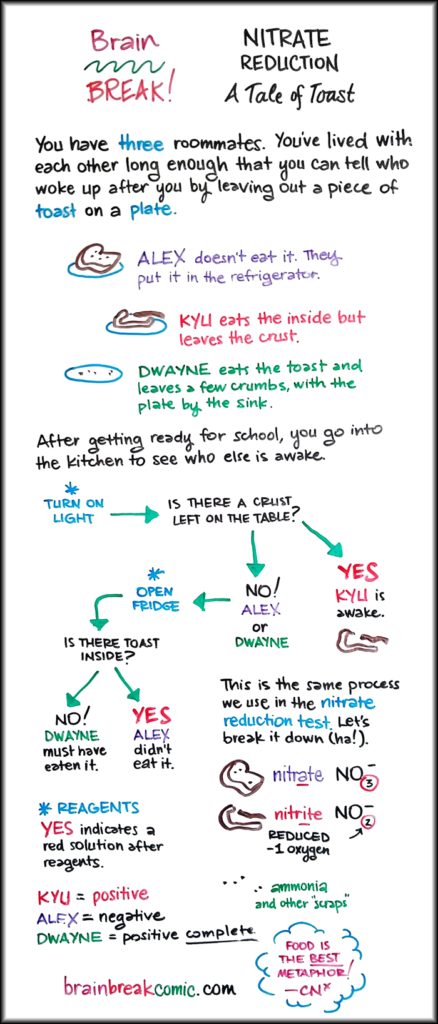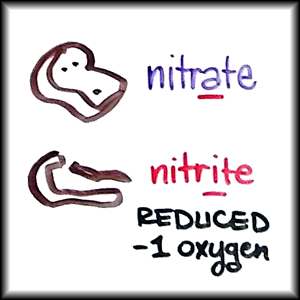
Brain BREAK! presents: Nitrate Reduction: A Tale of Toast.
Bacteria metabolism tests, especially when trying to clinch an unknown, can be dizzying. Keeping track of which stage is which and what each result represents is a lot to keep in one head. Let’s break it down (no pun intended) with a little story:
You have three roommates. You’ve lived when each other long enough that you can tell who woke up after you by leaving out a piece of toast on a plate. Maybe you want to know who is trying to shower at the same time and stealing at the hot water. Anyway, toast.
- Alex doesn’t eat it. They put it in the refrigerator.
- Kyu eats the inside but leaves the crust.
- Dwayne eats the toast and leaves only a few crumbs, with the plate by the sink.
After getting ready for school, you go into the kitchen to see who else is awake.
ACTION: Turn on the light.
- Observe: Is there a crust left on the table?
- If yes, Kyu is awake.
- If no, proceed to step 2.
ACTION: Open the fridge.
- Observe: Is there toast in the fridge?
- If yes, Alex didn’t eat it. It’s been left in the fridge – whole.
- If no, Dwayne must have eaten it.
We use this same kind of process in the nitrate reduction test. In this example, each ACTION represents the addition of reagents; each yes indicates when the solution will turn red. What this test does in microbiology is find out what kind of roommate a mystery bacterium is – do they not eat the toast? Do they eat most of the toast? Or do they eat the toast pretty much whole?
Let’s talk about the toast that is nitrate.
Its chemical formula is NO3-. That’s one nitrogen, three oxygens and a little charge for spice. In this case, when we reduce nitrate, we are talking about reducing the number of oxygen atoms in it.
Nitrite is NO2-. It has one less oxygen than nitrate; likely because a bacterium is a facultative anaerobe and wanted to steal a little oxygen for a snack. This is our Kyu eating the soft part of the bread but leaving the crust, or nitrite, as a byproduct. (How I remember: nitrite is so trite with its two little oxygens.)
Now let’s take a look at Dwayne. In this bacterium, they eat the crust too, and there’s not much left other than crumbs. In this case, there’s little to no nitrite because it’s been broken down past nitrite. What’s left of this is ammonia, N2, and other little scraps of nitrogen-based junk.
In terms of the bacteria test, Alex is a negative for nitrate reduction, Kyu is a positive, and Dwayne is a complete positive – because he’s completely broken it down.
Food is the best metaphor! -CNx
P.S. In an aquarium, this process works backwards. Fish pee ammonia, or NH3 (otherwise one of Dwayne’s byproducts). This is very toxic! Ideally, your tank is home to bacteria that glom oxygen onto the ammonia, making nitrite. But nitrite isn’t great for fish, either. Other kinds of bacteria can swoop in and munch on the nitrites to make nitrate. And then aquarium plants or corals use the nitrate for their growth. It’s a whole little ecosystem. That’s why an aquarium requires so much testing and checking. Whether your fish thrive or become floaters depends on your microbiome – if you have each kind of microbe doing their part to metabolize nitrogen-based molecules. It takes all kinds!
